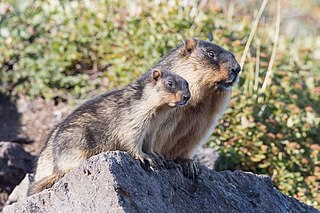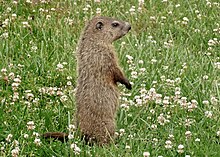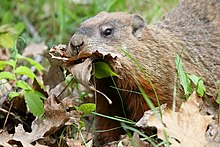
Marmots are large ground squirrels in the genus Marmota, with 15 species living in Asia, Europe, and North America. These herbivores are active during the summer, when they can often be found in groups, but are not seen during the winter, when they hibernate underground. They are the heaviest members of the squirrel family.

Ground squirrels are rodents of the squirrel family (Sciuridae) that generally live on the ground or in burrows, rather than in trees like the tree squirrels. The term is most often used for the medium-sized ground squirrels, as the larger ones are more commonly known as marmots or prairie dogs, while the smaller and less bushy-tailed ground squirrels tend to be known as chipmunks.

The hoary marmot is a species of marmot that inhabits the mountains of northwest North America. Hoary marmots live near the tree line on slopes with grasses and forbs to eat and rocky areas for cover.

The Vancouver Island marmot naturally occurs only in the high mountains of Vancouver Island, in British Columbia. This particular marmot species is large compared to some other marmots, and most other rodents. Marmots are the largest members of the Sciuridae family, with weights of adults varying from 3 to 7 kg depending on age and time of year.

The American badger is a North American badger similar in appearance to the European badger, although not closely related. It is found in the western, central, and northeastern United States, northern Mexico, and south-central Canada to certain areas of southwestern British Columbia.

The yellow-bellied marmot, also known as the rock chuck, is a large, stout-bodied ground squirrel in the marmot genus. It is one of fourteen species of marmots, and is native to mountainous and semi-arid regions of southwestern Canada and western United States, including the Rocky Mountains, Sierra Nevada, and the Great Basin, often living above 2,000 metres. The fur is mainly brown, with a dark bushy tail, yellow chest and white patch between the eyes, and they weigh up to approximately 5 kilograms. They live in burrows in colonies of up to twenty individuals with a single dominant male. They are diurnal and feed on plant material, insects, and bird eggs. They hibernate for approximately eight months starting in September and lasting through the winter.

The alpine marmot is a large ground-dwelling squirrel, from the genus of marmots. It is found in high numbers in mountainous areas of central and southern Europe, at heights between 800 and 3,200 m (2,600–10,500 ft) in the Alps, Carpathians, Tatras and Northern Apennines. In 1948 they were reintroduced with success in the Pyrenees, where the alpine marmot had disappeared at end of the Pleistocene epoch.

The Olympic marmot is a rodent in the squirrel family, Sciuridae; it occurs only in the U.S. state of Washington, on the middle elevations of the Olympic Peninsula. The closest relatives of this species are the hoary marmot and the Vancouver Island marmot. In 2009, it was declared the official endemic mammal of Washington.

The Himalayan marmot is a marmot species that inhabits alpine grasslands throughout the Himalayas and on the Tibetan Plateau. It is IUCN Red Listed as Least Concern because of its wide range and possibly large population.

The Arctic ground squirrel is a species of ground squirrel native to the Arctic and Subarctic of North America and Asia. People in Alaska, particularly around the Aleutians, refer to them as "parka" squirrels, most likely because their pelt is good for the ruff on parkas and for clothing.

Belding's ground squirrel, also called pot gut, sage rat or picket-pin, is a squirrel that lives on mountains in the western United States. In California, it often is found at 6,500 to 11,800 feet (2,000–3,600 m) in meadows between Lake Tahoe and Kings Canyon. This species is not of conservation concern, and its range includes some protected areas.

The long-tailed marmot or golden marmot is a marmot species in the family Sciuridae. It occurs in mountainous regions in the central parts of Asia where it lives in open or lightly wooded habitats, often among rocks where dwarf junipers grow. It is IUCN Red Listed as Least Concern. As suggested by its name, it is a relatively long-tailed species of marmot.

The gray marmot, grey marmot, or Altai marmot is a species of rodent in the squirrel family Sciuridae. It is one of the larger marmots in the genus Marmota. It occurs in mountainous grasslands and shrub lands of central Asia, and is one of the 9 Palearctic (Eurasia) species. It is found in Xinjiang Province in China, southeastern Kazakhstan, Kyrgyzstan, Mongolia, and in the Altai and Tien Shan Mountains in southeastern Siberia in Russia. In the Mongolian Altai, its range overlaps with that of the Tarbagan marmot. Gray marmots form social groups, live in burrows, and hibernate.

The Alaska marmot, also known as the Brooks Range marmot or the Brower's marmot, is a species of rodent in the family Sciuridae. Once considered to be the same species as the hoary marmot, it is now known to be unique. Alaska marmots are found in the scree slopes of the Brooks Range, Alaska. Specifically, they prefer to dwell on rocky, mountainous terrain, generally near lakes. They eat vegetation found on mountainsides, such as grasses, seeds, and lichen. Their relatively thick bodies are covered in dense, grey fur. They live in large colonies that consist of multiple families. During the winter, they hibernate for long periods of time in burrows. While not well researched, they are not believed to be particularly threatened, by human activity or otherwise. The Alaskan government has designated February 2 as "Marmot Day," a holiday intended to recognize the prevalence of marmots in the state, similar to the more widely celebrated American holiday of Groundhog Day.

The black-capped marmot is a species of rodent in the family Sciuridae. It is endemic to the Russian Far East, but its range is discontinuous and divided into three main parts, each with its own subspecies. The black-capped marmot lives in arctic tundra and alpine habitats from near sea-level to an altitude of 2,000 m (6,600 ft). Depending on exact subpopulation, they hibernate for 6–8 months each year, which is long for a marmot.

The tarbagan marmot is a species of rodent in the family Sciuridae. It is found in China, northern and western Mongolia, and Russia. In the Mongolian Altai Mountains, its range overlaps with that of the Gray marmot. The species was classified as endangered by the IUCN in 2008.

The Columbian ground squirrel is a species of rodent common in certain regions of Canada and the northwestern United States. It is the second largest member of the genus Urocitellus, which is part of the tribe Marmotini, along with marmots, chipmunks, prairie dogs, and other holarctic ground squirrels. They are stout, with short dense fur, which is characteristically tawny across the bridge of the nose. Social encounters sometimes are initiated with kissing behavior and the most common activity above ground is standing at attention. Residing in mountainous terrain and high plains in northern latitudes, they hibernate for 8 to 9 months of the year in burrows, which may be used for many years. They are emaciated when emerging in the spring. The Columbian ground squirrel came to the attention of the scientific community through writings produced by Lewis and Clark, while 21st century molecular genetics has more finely illuminated its ties with other close relatives.

Nesting behavior refers to an instinct in animals during reproduction to prepare a place with optimal conditions for offspring. The nesting place provides protection against predators and competitors that mean to exploit or kill offspring. It also provides protection against the physical environment.
Diandrya is a genus of cestode parasites that are known from marmots in North America. The species Diandrya composita, described along with the genus by J. G. Darrah in 1930, is known from all North American marmots except the woodchuck. The species D. vancouverensis, described by T. F. Mace and C. D. Shepard in 1981, is only known from the Vancouver Island marmot, an island endemic on Vancouver Island. Subsequent research confirmed D. vancouverensis to be genetically unique from D. composita.

The Tatra marmot is an endemic subspecies of marmot found in the Tatra Mountains. In the past, it was a game animal, but in the 19th century, its population drastically declined. It is a herbivore active in the summer, living in territorial family clans in the mountains from the upper montane to the alpine zone. It is one of the rarest vertebrates in Poland and is subject to strict legal protection. It is also legally protected in Slovakia. The Red List of Threatened Animals in Poland and the Polish Red Book of Animals classify the Tatra marmot as a strongly endangered subspecies (EN), while the Red List for the Carpathians in Poland designates it as "CR" – critically endangered. It is a relatively poorly researched animal.






























